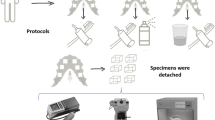Abstract
The aim of the study was to assess the thickness of softened enamel removed by toothbrushing. Human enamel specimens were indented with a Knoop diamond. Softening was performed with citric acid or orange juice. The specimens were brushed in a brushing machine with a manual soft toothbrush in toothpaste slurry or in artificial saliva. Enamel loss was calculated from the change in indentation depth of the same indent before and after abrasion. Mean surface losses (95% confidence interval) were recorded in treatment groups (in nanometers): (1) citric acid, abrasion with slurry = 339 (280–398); (2) citric acid, abrasion with artificial saliva = 16 (5–27); (3) orange juice, abrasion with slurry = 268 (233–303); (4) orange juice, abrasion with artificial saliva = 14 (5–23); (5) no softening, abrasion with slurry = 28 (10–46). The calculated thickness of the softened enamel varied between 254 and 323 nm, depending on the acid used.
Similar content being viewed by others
References
Ten Cate JM, Imfeld T (1996) Dental erosion, summary. Eur J Oral Sci 104:241–244
Featherstone JDB, Lussi A (2006) Understanding the chemistry of dental erosion. In: Lussi A (ed) Dental erosion. Karger, Basel, pp 66–76
Ten Cate JM, Larsen MJ, Pearce EIF, Fejerskov O (2003) Chemical interactions between the tooth and oral fluids. In: Fejerskov O, Kidd E (eds) Dental caries: the disease and its clinical management. Blackwell Munksgaard, Oxford, pp 59–65
Dawes C (2003) What is the critical pH and why does a tooth dissolve in acid? J Can Dent Assoc 69:722–724
Jaeggi T, Lussi A (1999) Toothbrush abrasion of erosively altered enamel after intraoral exposure to saliva: an in situ study. Caries Res 33:455–461
Wiegand A, Wegehaupt F, Werner C, Attin T (2007) Susceptibility of acid-softened enamel to mechanical wear-ultrasonication versus toothbrushing abrasion. Caries Res 41:56–60
Addy M (2005) Tooth brushing, tooth wear and dentine hypersensitivity—are they associated? Int Dent J 55:261–267
Hemingway CA, Parker DM, Addy M, Barbour ME (2006) Erosion of enamel by non-carbonated soft drinks with and without toothbrushing abrasion. Br Dent J 201:447–450
Attin T (2006) Methods for assessment of dental erosion. In: Lussi A (ed) Dental erosion. Karger, Basel, pp 152–172
Otis LL, Everett MJ, Sathyam US, Colston BW (2000) Optical coherence tomography: a new imaging technology for dentistry. J Am Dent Assoc 131:511–514
Lussi A, Jaeggi T, Schaerer S (1993) The influence of different factors on in vitro enamel erosion. Caries Res 27:387–393
Zero DT, Rahbek I, Fu J, Proskin HM, Featherstone JDB (1990) Comparison of the iodide permeability test, the surface microhardeness test and mineral dissolution of bovine enamel following acid challenge. Caries Res 24:181–188
Chen PS, Toribara TY, Warner H (1956) Microdetermination of phosphorus. Anal Chem 28:1756–1758
Lussi A, Hellwig E (2001) Erosive potential of oral care products. Caries Res 35:52–56
Newby CS, Creeth JE, Rees GD, Schemehorn BR (2006) Surface microhardness changes, enamel fluoride uptake, and fluoride availability from commercial toothpastes. J Clin Dent 17:94–99
Brunner E, Domhof S, Langer F (2002) Nonparametric analysis of longitudinal data in factorial designs. Wiley, New York
British Standards Institution (1979) Precision of test methods. Guide for the determination and reproducibility for a standard test method (BS 5497, part 1). British Standards Institution, London
Bland JM, Altman DG (1986) Statistical methods for assessing agreement between two methods of clinical measurement. Lancet 1:307–310
Larsen MJ, Nyvad B (1999) Enamel erosion by some soft drinks and orange juices relative to their pH, buffering effect and contents of calcium phosphate. Caries Res 33:81–87
Attin T, Buchalla W, Gollner M, Hellwig E (2000) Use of variable remineralization periods to improve the abrasion resistance of previously eroded enamel. Caries Res 34:48–52
Eisenburger M, Addy M (2003) Influence of liquid temperature and flow rate on enamel erosion and surface softening. J Oral Rehab 30:1076–1080
Ganss C, Klimek J, Lussi A (2006) Accuracy and consistency of the visual diagnosis of exposed dentine on worn occlusal/incisal surfaces. Caries Res 40:208–212
Lippert F, Parker DM, Jandt KD (2004) Toothbrush abrasion of surface softened enamel studied with tapping mode AFM and AFM nanoindentation. Caries Res 38:464–472
Voronets J, Jaeggi T, Buergin W, Lussi A (2008) Controlled toothbrush abrasion of softened human enamel. Caries Res 42:286–290
Parry J, Harrington E, Rees GD, McNab R, Smith AJ (2008) Control of brushing variables for the in vitro assessment of toothpaste abrasivity using a novel laboratory model. J Dent 36:117–124
Joiner A, Schwarz A, Philpotts CJ, Cox TF, Huber K, Hannig M (2008) The protective nature of pellicle towards toothpaste abrasion on enamel and dentine. J Dent 36:360–368
Acknowledgement
The authors wish to thank Stefanie Hayoz and Prof. J. Huesler for the statistical advice.
Conflicts of interest
The authors declare that they have no conflicts of interest.
Author information
Authors and Affiliations
Corresponding author
Rights and permissions
About this article
Cite this article
Voronets, J., Lussi, A. Thickness of softened human enamel removed by toothbrush abrasion: an in vitro study. Clin Oral Invest 14, 251–256 (2010). https://doi.org/10.1007/s00784-009-0288-y
Received:
Accepted:
Published:
Issue Date:
DOI: https://doi.org/10.1007/s00784-009-0288-y




